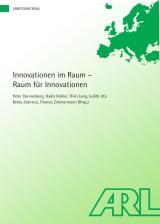Innovationen im Raum - Raum für Innovationen

Innovationen und Innovationsfähigkeit stehen derzeit hoch im Kurs. In der wissenschaftlichen und politischen Diskussion wird ihnen ein hoher Stellenwert für die wirtschaftliche Entwicklung beigemessen. Bereits im Jahr 2000 verabschiedeten die europäischen Staats- und Regierungschefs die Lissabon-Strategie mit dem Ziel, Innovationen zu fördern, um die Europäische Union bis zum Jahr 2010 zum wettbewerbsfähigsten und dynamischsten Wirtschaftsraum der Erde zu entwickeln. Ausgehend von einer überwiegend ökonomisch geführten Diskussion halten in jüngster Zeit neue Perspektiven Einzug in die Debatte. Es werden zunehmend soziale und ökologische Aspekte thematisiert. Beispielsweise gelten in der aktuellen Klimaschutzdebatte innovative Techniken als Voraussetzung für ein nachhaltiges Wachstum. In den Raumwissenschaften werden Innovationen und Innovationsfähigkeit im Zusammenhang mit kreativen Milieus oder Wissensregionen diskutiert.
Das Junge Forum der Akademie für Raumforschung und Landesplanung (ARL) griff mit seiner Tagung „Innovationen im Raum - Raum für Innovationen" vom 21. bis 23. Mai 2008 in Berlin dieses hochaktuelle Thema auf. Ziel der Tagung war es, innovative Räume und die Bedingungen, unter denen sie entstehen, zu analysieren sowie der Frage nachzugehen, wie Innovationen gefördert werden können und welche Auswirkungen sie im Raum haben können.
Die vorgetragenen und diskutierten Beiträge aus Wissenschaft und Praxis sind Gegenstand dieses Arbeitsmaterials. Neben grundlegenden Fragestellungen beziehen sich die Beiträge auf vier übergeordnete Themenbereiche:
- Innovative Räume
- Förderung von Innovationen
- Neue Raumnutzungen und innovative Planungsprozesse
- Der räumliche Fußabdruck von Innovationen
Innovations and innovative potential are currently in high demand. The discussion in both academic and political circles regards them as being of great importance for economic development. As long ago as the year 2000, the EU Heads of State and of Government adopted the Lisbon Strategy with the specific aim of promoting innovation as a means of developing the European Union by 2010 into the world's most competitive and dynamic economic area. More recently, and emanating from a largely economics-based discussion, a number of new perspectives have been added to the debate. Attention has been drawn increasingly to social and ecological aspects. To take one example: in the current debate on climate protection, innovative technologies are frequently viewed as essential prerequisites for sustainable growth. Within the spatial sciences, innovation and innovative potential are discussed in the context of creative milieus or knowledge regions.
At its most recent conference, dedicated to "Innovations in Space - Space for Innovations" and held in Berlin from May 21st to 23rd 2008, the ARL's Junges Forum (the Young Planners' Forum at the Academy for Spatial Research and Planning) dedicated the entire event to this burning issue. The aim of the conference was to analyse innovative spaces and the conditions under which they emerge, and both to explore the question of how innovation can be supported and to examine its spatial impacts.
This collection of working materials brings together the papers presented for discussion by both planning scholars and planning practitioners. As well as touching on various more fundamental issues, the papers relate to four superordinate topic areas:
- Innovative spaces
- Supporting innovation
- New uses of space and innovative planning processes
- The spatial footprint of innovations.



